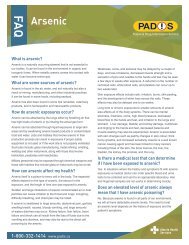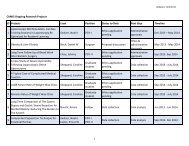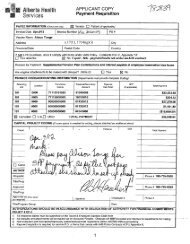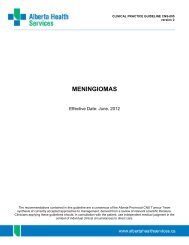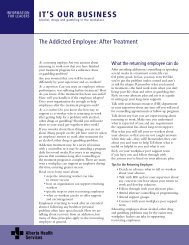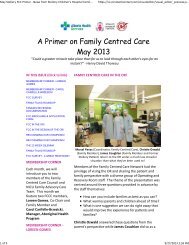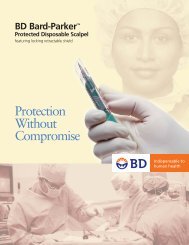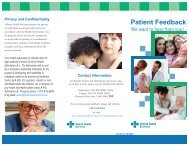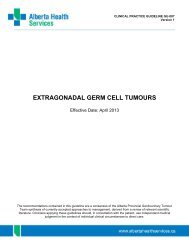Myelodysplastic Syndromes - Alberta Health Services
Myelodysplastic Syndromes - Alberta Health Services
Myelodysplastic Syndromes - Alberta Health Services
Create successful ePaper yourself
Turn your PDF publications into a flip-book with our unique Google optimized e-Paper software.
CLINICAL PRACTICE GUIDELINE LYHE-004<br />
MYELODYSPLASTIC SYNDROMES<br />
Date Developed: November, 2007<br />
Date Revised: November, 2009<br />
The recommendations contained in this guideline are a consensus of the <strong>Alberta</strong> Provincial Hematology Tumour<br />
Team synthesis of currently accepted approaches to management, derived from a review of relevant scientific<br />
literature. Clinicians applying these guidelines should, in consultation with the patient, use independent medical<br />
judgment in the context of individual clinical circumstances to direct care.
BACKGROUND<br />
CLINICAL PRACTICE GUIDELINE LYHE-004<br />
<strong>Myelodysplastic</strong> syndromes (MDS) are a collection of clonal neoplastic bone marrow disorders<br />
characterized by ineffective hematopoiesis, cytopenias, and frequent cytogenetic abnormalities. 1,2 MDS<br />
occurs most frequently in the elderly, with a median age at diagnosis of 65-70 years, and the population<br />
prevalence increases with age. 1-4 Progression to acute leukemia is seen in approximately 30 percent of<br />
patients; there is a spectrum of disease between myelodysplastic syndromes and acute leukemia with<br />
common cytogenetic abnormalities. While some patients have relatively slow disease progression, others<br />
will experience progressive cytopenias that will eventually result in death. 1-4<br />
The etiology of MDS is most commonly idiopathic; risk factors include exposure to benzenes, phenols,<br />
other industrial chemicals including heavy metals, and cigarette smoke. MDS is frequently secondary to<br />
exposure to ionizing radiation or chemotherapy, such as alkylating agents and topoisomerase-II inhibitors.<br />
In a minority of patients, MDS is associated with prior hematologic disorders such as aplastic anemia or<br />
paroxysmal nocturnal hemoglobinuria. A familial genetic link is frequent in children and rare in adults. 4<br />
MDS can arise out of constitutional genetic disorders (trisomy 21, trisomy 8 mosaicism, familial monosomy<br />
7), congenital neutropenias (Shwachman-Diamond or Kostmann’s syndrome), or defective DNA repair<br />
(Fanconi’s anemia, ataxia-telangiectasia, Bloom’s syndrome). 5 Cytogenetic abnormalities are found in 40-<br />
70 percent of de novo MDS and contribute to a less favourable prognosis. 6-7<br />
GUIDELINE GOALS AND OBJECTIVES<br />
To identify the diagnostic criteria for MDS.<br />
To identify the management options for MDS, including supportive care and disease-modifying<br />
therapy.<br />
To outline prognostic markers for MDS.<br />
GUIDELINE QUESTIONS<br />
What are the diagnostic and prognostic criteria for myelodysplastic syndromes?<br />
What are the most suitable management strategies for myelodysplastic syndromes?<br />
DEVELOPMENT PANEL<br />
This guideline was reviewed and endorsed by the <strong>Alberta</strong> Provincial Hematology Tumour Team.<br />
Members of the <strong>Alberta</strong> Provincial Hematology Tumour Team include medical oncologists, radiation<br />
oncologists, surgical oncologists, hematologists, nurses, nurse-practitioners, pathologists, and<br />
pharmacists. Updated evidence was selected and reviewed by a working group comprised of members<br />
from the <strong>Alberta</strong> Provincial Hematology Tumour Team and a Knowledge Management Specialist from the<br />
Guideline Utilization Resource Unit.<br />
SEARCH STRATEGY<br />
For this guideline update, the MEDLINE, PubMed, Cochrane Database of Systematic Reviews, Cochrane<br />
Register of Controlled Trials, and EMBASE databases were searched for publications between January<br />
2008 and November 2009. In addition, the 2008 and 2009 ASCO and ASH Abstracts and Proceedings<br />
were reviewed. Search terms included <strong>Myelodysplastic</strong> Syndrome* AND [practice guidelines OR<br />
systematic review* OR review OR trial* OR clinical trial] AND [treatment OR management OR therapy OR
CLINICAL PRACTICE GUIDELINE LYHE-004<br />
chemotherapy OR diagnosis OR prognosis]. In addition, the updated search yielded relevant clinical<br />
practice guidelines published by the National Comprehensive Cancer Network (NCCN), American Society<br />
of Hematology, (ASH), American Society of Clinical Oncology (ASCO), and the British Committee for<br />
Standards in Haematology (BCSH). 8-11<br />
RECOMMENDATIONS<br />
Diagnosis and Prognosis:<br />
1. The hallmark of diagnosis is dysplasia in >10% of cells in at least 1 cell lineage on bone marrow<br />
aspiration and biopsy. In patients with hypocellular marrow, the presence of dysplasia and cytogenetic<br />
abnormalities support the diagnosis of MDS over aplastic anemia.<br />
2. Immunophenotyping and quantification of blasts by flow cytometry and full karyotype cytogenetic<br />
testing should be performed on the bone marrow.<br />
3. In hypoplastic patients, paroxysmal nocturnal hemoglobinuria (PNH) screening should be performed<br />
on bone marrow or peripheral blood (flow cytometry for CD55 and CD59).<br />
4. Causes of marrow dysplasia other than MDS should be ruled out before making a diagnosis of<br />
myelodysplasia, including viruses, drugs, and vitamin deficiencies.<br />
5. All patients should have prognostication based on calculation of IPSS and WHO prognostic scales.<br />
Treatment:<br />
6. Hematopoietic stem cell transplantation (HSCT) is the only curative therapy available for MDS.<br />
Sibling typing should be initiated in transplant-eligible patients who are Int-1 IPSS score or<br />
higher.<br />
Low or Int-1 risk disease: eligible patients with significant symptomatic cytopenias and/or<br />
evidence of transforming disease should be considered for allogeneic HSCT.<br />
Int-2 or High risk disease: allogeneic HSCT should be offered as first line therapy to eligible<br />
patients, especially those age20%,<br />
induction chemotherapy is not necessary prior to allogeneic transplantation.<br />
In patients with a blast count 10%, total body irradiation (200 cGy x 2 doses) should be added<br />
to FLUBUP conditioning to reduce relapse risk.<br />
Options for relapsed disease include palliation, DLI or second transplant.<br />
7. As a majority of the patients are elderly and not eligible for HSCT, the goals of therapy range from<br />
symptom control and improved quality of life to reducing development of acute leukemia and<br />
prolongation of survival.
Supportive Care:<br />
CLINICAL PRACTICE GUIDELINE LYHE-004<br />
8. Transfusions:<br />
Red cell transfusions should be employed as required to treat and prevent significant symptoms<br />
of anemia; unnecessary transfusions should be avoided to prevent symptomatic iron overload.<br />
Platelet transfusions as required to prevent bleeding due to symptomatic thrombocytopenia.<br />
o Single donor platelets are preferred in patients with expected prolonged platelet transfusion<br />
dependency to decrease risk of HLA sensitization and platelet antibody production.<br />
CMV negative blood products are suggested for CMV negative transplant candidates.<br />
9. Infections: Antibiotic therapy for infections and neutropenic fever should be used as clinically indicated<br />
to advance the above goals of therapy.<br />
10. Bleeding: Tranexamic acid therapy can be considered for severely thrombocytopenic patients with<br />
mucosal bleeding. ASA, NSAIDs, and systemic anticoagulation should be avoided in patients with<br />
platelets less than 50 or significant bleeding.<br />
11. Vitamin Supplementation: B12 and folate therapy should be performed in patients with nutritional<br />
deficiencies.<br />
12. Iron Chelation:<br />
Iron chelation should be considered in patients with a life expectancy of greater than 1 year, and<br />
either ferritin >1000, >20 units blood transfused or documented organ iron overload, especially if<br />
red cell transfusions are ongoing or iron stores are increasing due to ineffective erythropoiesis.<br />
Iron chelation is indicated in patients with increased iron stores who are planning HSCT.<br />
Transfusion dependent or iron overloaded patients should be encouraged to avoid ironcontaining<br />
supplements and multivitamins.<br />
Chelation can be initiated with deferoxamine (20-50 mg/kg/day by subcutaneous or intravenous<br />
infusion over 8-12 hours or bid sc bolus injections 5 days/week) or deferasirox 20-30 mg/kg<br />
orally daily.<br />
Monitor for complications of iron overload and complications of drug therapy while administering<br />
iron chelation.<br />
13. The patient’s psychosocial situation should be monitored, and consultation made to social work,<br />
psychosocial services, home care or other supportive agencies as required.<br />
Therapeutic Options for IPSS Low and Int-1 Myelodysplasia:<br />
14. In patients with Low or Int-1 IPSS myelodysplasia, erythropoietin levels
CLINICAL PRACTICE GUIDELINE LYHE-004<br />
16. Patients on growth factors should have iron stores assessed to ensure they are iron replete prior to<br />
and throughout therapy.<br />
17. Immunomodulators<br />
Patients with Low or Int-1 IPSS scores and a del (5q) abnormality, with or without other<br />
cytogenetic abnormalities, and symptomatic anemia should be given first-line treatment with<br />
lenalidomide 10 mg/d 21 days per month or 10 mg daily.<br />
Patients receiving lenalidomide should be monitored for the development of cytopenias with<br />
weekly CBCs for the first 8 weeks and dose reductions introduced as necessary.<br />
Dose reductions should be made in patients with renal insufficiency.<br />
Lenalidomide is the treatment option for all patients with Low or Int-1 risk IPSS myelodysplastic<br />
syndrome who are red cell transfusion dependent regardless of del (5q) status, using a<br />
treatment regimen of 10 mg/d 21 days/month or 10 mg daily dosing.<br />
18. Immune Suppression: In patients with Low and Int-1 IPSS MDS, especially in the presence of a<br />
hypocellular marrow, PNH clone, and/or HLA-DR15 (DR2) positivity, and a short duration of red cell<br />
transfusion dependence, consider a course of immunosuppression with ATG 40 mg/kg/d IV over 4-6<br />
days cyclosporine starting at 5 mg/kg/d for a 6 month period.<br />
Therapeutic Options for Int-2 and High Risk Myelodysplasia:<br />
19. Demethylation Agents<br />
In patients with Int-2 or High Risk IPSS MDS who are not candidates for intensive chemotherapy<br />
and HSCT, or Int-1 IPSS patients with significant cytopenias, therapy with azacytidine or<br />
decitabine should be considered.<br />
Azacytidine dose is 75 mg/m 2 per day sc for seven consecutive days every 28 days, with a<br />
minimum of 4 cycles before assessment of response. Treatment is continued for duration of<br />
clinical response.<br />
Decitabine dose is 20 mg/m 2 IV daily x 5 days every 28 days and is continued for the duration of<br />
response.<br />
20. Chemotherapy: Intensive chemotherapy for MDS with excess blasts may be useful in patients with<br />
rapidly increasing blast counts as a bridge to hematopoietic cell transplantation; clinical trials are<br />
needed.<br />
Additional Considerations for Chronic Myelomonocytic Leukemia:<br />
21. At diagnosis, all patients should have a full cytogenetic profile performed and FISH performed for<br />
t(5:12) where available.<br />
22. Patients with t(5:12) or other PDGFR mutations should be offered therapy with imatinib mesylate.
DISCUSSION<br />
Pathophysiology 12<br />
CLINICAL PRACTICE GUIDELINE LYHE-004<br />
MDS is associated most commonly with a hypercellular bone marrow, with increased proliferation of<br />
neoplastic cells and either increased or defective apoptosis. Eight to 28 percent of patients have<br />
hypocellular marrows. MDS likely develops from a number of heterogeneous pathways. DNA damage is a<br />
common factor, with evolution of clonal cytogenetic abnormalities and frequent abnormalities in DNA<br />
methylation and epigenetics. Certain genetic abnormalities are associated with MDS, such as the<br />
inactivation of the p53 tumour suppressor gene. Interaction between neoplastic cells and the<br />
microenvironment is increasingly recognized as key for the survival and proliferation of the abnormal<br />
clone; cytokine release/response and abnormalities in immune suppression are also associated with the<br />
disease. Some patients have an overlap syndrome with characteristics of both myelodysplasia and<br />
myeloproliferative disease.<br />
Diagnostic Criteria 1,13,14<br />
Family history of anemia, MDS or hematologic disease, evidence of congenital abnormalities, or<br />
exposures to chemotherapy, radiation, or toxic environmental or occupational exposures should be<br />
elicited. MDS is a diagnosis of exclusion, as dysplasia can be the result of factors other than a clonal<br />
disorder. All patients should be assessed for an effect on marrow function from drugs (including<br />
chemotherapy drugs), viral infections (i.e., parvovirus), nutrient deficiencies, alcohol ingestion, heavy<br />
metal exposure (i.e., arsenic) and recovery from other recent toxin exposures. Symptoms are those of<br />
bone marrow failure and include symptoms of anemia, infections and bleeding. Less commonly, fever and<br />
weight loss are observed.<br />
Investigations<br />
CBC and differential, reticulocytes, peripheral blood smear, B12 and folate levels.<br />
HIV testing for those with risk factors. In patients undergoing immunosuppressive or<br />
myelosuppressive treatment, screen for viral hepatitis with hepatitis C antibody, hepatitis BsAb,<br />
hepatitis BsAg, and hepatitis C core antibody.<br />
In hypoplastic patients, paroxysmal nocturnal hemoglobinuria (PNH) screening should be performed<br />
on bone marrow or peripheral blood (flow cytometry for CD55 and CD59).<br />
Bone marrow aspirate and biopsy including a 500 cell count with morphology, reticulin staining for<br />
fibrosis and iron stains for assessment of ringed sideroblasts.<br />
Immunophenotyping and quantification of blasts by flow cytometry and full karyotype cytogenetic<br />
testing should be performed on the bone marrow.<br />
Serum erythropoietin levels in patients for whom erythropoietin treatment is being considered.<br />
Assessment of iron stores including Fe, total iron binding capacity (TIBC), and ferritin for evidence of<br />
iron overload.<br />
Human leukocyte antigen (HLA) DR typing should be performed if considering immunosuppressive<br />
therapy.<br />
o Increased response with HLA DR15 (HLA DR2).<br />
HLA-A, B, C, DR, and DQ tissue typing in patients who are HSCT transplant candidates.
CLINICAL PRACTICE GUIDELINE LYHE-004<br />
The hallmark of diagnosis is dysplasia in >10% of cells in at least 1 cell lineage on bone marrow aspiration<br />
and biopsy. In patients with hypocellular marrows the presence of dysplasia and cytogenetic<br />
abnormalities support the diagnosis of MDS over aplastic anemia. In hypoplastic patients, PNH screening<br />
should be performed on bone marrow or peripheral blood (flow cytometry for CD55 and CD59). Causes of<br />
marrow dysplasia other than myelodysplastic syndromes should be ruled out before making a diagnosis of<br />
myelodysplasia, including viruses, drugs, and vitamin deficiencies.<br />
Classification<br />
The French-American-British (FAB) classification system has been largely replaced by the World <strong>Health</strong><br />
Organization (WHO) classification system; it is included here because many studies still refer to these<br />
criteria. 15-17 The WHO classification eliminates the RAEB-T category by replacing it with the diagnosis of<br />
acute leukemia when blasts are >20%. 13 This includes some cytogenetic information, and considers<br />
CMML with the myeloproliferative disorders. Tables 1 and 2 describe the components of both classification<br />
systems.<br />
Table 1. FAB Classification of MDS<br />
FAB Classification % Blasts BM % Blasts PB<br />
Refractory anemia (RA) < 5 < 1<br />
Refractory anemia with ringed sideroblasts (RARS)* < 5 < 1<br />
Refractory anemia with excess blasts (RAEB) 5-20 < 5<br />
RAEB transformation (RAEB-T) 21-30 or > 5<br />
Chronic myelomonocytic leukemia (CMML) < 20 < 5<br />
*Ringed sideroblasts >15% nucleated marrow erythroid cells<br />
Table 2. WHO Classification of MDS<br />
WHO Classification % Blasts BM % Blasts PB<br />
RA/RARS* < 5 none/rare<br />
Refractory cytopenia with multi-lineage dysplasia (RCMD)/ RCMD-RS* (bi- < 5 none/rare<br />
lineage or tri-lineage dysplasia)<br />
RAEB-1 < 5 5-9<br />
RAEB-2 5-19 10-19<br />
MDS – unclassified < 5 none/rare<br />
MDS with isolated del(5q)<br />
Female predominance, transfusion-dependent anemia; normal or<br />
increased platelet counts with hypolobulated micromegakaryocytes in<br />
the hyperplastic marrow; low incidence of transformation into acute<br />
leukemia<br />
< 5 < 5<br />
*Ringed sideroblasts 15% of nucleated marrow erythroid cells<br />
Prognosis<br />
The International Prognostic Scoring System (IPSS) for MDS was developed to predict prognosis for adult<br />
patients at the time of diagnosis. 17 It was developed based on the FAB classification system; patients with<br />
20-30% blasts would now be considered to have AML. Patients with extensive prior chemotherapy<br />
treatment and secondary MDS were not included in the development or validation of this scoring system.<br />
It is not validated for use at time points after diagnosis.
CLINICAL PRACTICE GUIDELINE LYHE-004<br />
Table 3. International Prognostic Scoring System<br />
Score 0 0.5 1 1.5 2<br />
% Blasts 3), abnormalities<br />
of chromosome 7<br />
Intermediate – all others<br />
good intermediate poor<br />
Cytopenias (Hb 9.4 (NR)<br />
INT-1 0.5-1 2.7 5.2 2.7 6.9<br />
INT-2 1.2-2 1.1 1.8 1.3 0.7<br />
High 2.5 0.5 0.3 0.2 0.2<br />
Abbreviations: NR = not reached<br />
The WHO system, shown in Table 5, has been integrated into a new prognostic system, which has been<br />
validated in a large cohort of patients and includes the need for transfusions as a negative prognostic<br />
factor. 14 It is a time-dependent scale that is valid at time points after diagnosis.<br />
Table 5. WHO Prognostic Scoring Scale<br />
Variable 0 1 2 3<br />
WHO classification Ra, RARS, 5q- RCMD, RCMD-RS RAEB-1 RAEB-2<br />
Karyotype Good Intermediate Poor --<br />
Transfusions No Regular -- --<br />
Table 6. Overall Survival and Time-to-AML Based on the WHO Prognostic Scoring Scale<br />
Risk Score Standardized Mortality Ratio Overall Survival (months) 2 year AML Progression<br />
Very low 0 1.8 141 0.03<br />
Low 1 3.47 66 0.06<br />
Intermediate 2 4.9 48 0.21<br />
High 3-4 16.18 26 0.38<br />
Very high 5-6 30.55 9 0.80<br />
The frequency of cytogenetic abnormalities generally increases with increasing severity of disease.
Other negative prognostic factors in MDS:<br />
Mutation and loss of heterogeneity in p53 gene<br />
Increased B2 microglobulin<br />
Mutations in FLT3<br />
CD34 positivity of nucleated bone marrow cells<br />
Increased expression of Wilms tumour gene WT1<br />
Therapy-related secondary MDS<br />
o 75% of patients have abnormalities in chromosomes 5 and/or 7<br />
o Higher proportion with p53 abnormalities<br />
CLINICAL PRACTICE GUIDELINE LYHE-004<br />
All patients should have prognostication based on calculation of IPSS and WHO prognostic scoring scale.<br />
Treatment<br />
The dilemma with myelodysplastic syndromes lies largely in the fact that this is a disease of the elderly.<br />
The majority of patients are not eligible for hematopoietic stem cell transplantation (HSCT), the only<br />
curative therapy. Disease that has progressed to acute leukemia has a lower response rate to<br />
chemotherapy than de novo leukemia, and is more likely to relapse. 19 The development of a blast count<br />
>20% does not mandate treatment for acute leukemia, and therapeutic decisions must account for a<br />
patients’ age, comorbidities, trajectory of disease development, and overall prognosis with therapy in<br />
addition to the patients’ treatment goals. Goals of therapy range from symptom control and improved<br />
quality of life to reducing development of acute leukemia and prolongation of overall survival. A select few<br />
patients are candidates for potentially curative therapy with stem cell transplantation. HSCT is the only<br />
curative therapy available for MDS.<br />
Supportive Care for All Patients with MDS<br />
Transfusions:<br />
Red cell transfusions should be employed as required to treat and prevent significant symptoms of<br />
anemia; unnecessary transfusions should be avoided to prevent symptomatic iron overload.<br />
Platelet transfusions to prevent bleeding due to symptomatic thrombocytopenia<br />
Single donor platelets are preferred in patients with expected prolonged platelet transfusion<br />
dependency to decrease risk of HLA sensitization and platelet antibody production.<br />
CMV negative blood products are suggested for CMV negative transplant candidates.<br />
Infections: Antibiotic therapy for infections and neutropenic fever should be used as clinically indicated to<br />
advance the above goals of therapy.<br />
Bleeding: Tranexamic acid therapy can be considered for severely thrombocytopenic patients with<br />
mucosal bleeding. ASA, NSAIDS, and systemic anticoagulation should be avoided in patients with<br />
platelets less than 50 or significant bleeding.<br />
Vitamin supplementation: Vitamin B12 and folate therapy should be performed in patients with<br />
nutritional deficiencies.<br />
Iron chelation: Iron overload is common in MDS as a result of increased intestinal iron absorption,<br />
ineffective hematopoiesis and iron infused during packed red cell transfusions (each unit of iron contains
CLINICAL PRACTICE GUIDELINE LYHE-004<br />
200-250 mg of iron, well above the 1-2 mg/day excreted by the body). In transfusion-dependent<br />
thalassemia, prospective data confirms improved survival in patients given iron chelation. Transfusion<br />
dependency in MDS has been associated with complications of iron overload including heart failure and<br />
conduction/rhythm disturbance, diabetes, and liver dysfunction. 20-21 In a retrospective review, a ferritin<br />
level of >1000 g/L was significantly associated with decreased overall survival, with a hazard ratio<br />
increasing by 30% for every 500 g/L rise in ferritin >1000 g/L. 16 In addition, a Canadian retrospective<br />
review found that predictors of survival in MDS were the IPSS score and iron chelation therapy, with a<br />
significantly longer overall survival in patients receiving chelation. 22 Chelation has been shown to be<br />
effective in decreasing total body iron load, and variably effective at removing iron from body organs. 23-24<br />
General principles of iron chelation include:<br />
Iron chelation should be considered in patients with a life expectancy of greater than 1 year, and<br />
either ferritin >1000, >20 units blood transfused or documented organ iron overload, especially if red<br />
cell transfusions are ongoing or iron stores are increasing due to ineffective erythropoiesis.<br />
Iron chelation is indicated in patients with increased iron stores who are planning HSCT.<br />
Transfusion dependent or iron overloaded patients should be encouraged to avoid iron-containing<br />
supplements and multivitamins.<br />
Chelation can be initiated with deferoxamine (20-50 mg/kg/day by subcutaneous or intravenous<br />
infusion over 8-12 hours or two times daily subcutaneous bolus injections 5 days/week) or<br />
deferasirox 20-30 mg/kg orally daily.<br />
Monitor for complications of iron overload and complications of drug therapy while administering iron<br />
chelation.<br />
Psychosocial support: The psychosocial situation of each patient should be monitored, and consultation<br />
made to social work, psychosocial services, home care or other supportive agencies as required.<br />
Therapeutic Options for IPSS Low and Int-1 Myelodysplasia<br />
Growth factors: The use of erythropoietin has been shown to increase the hemoglobin and reduce<br />
transfusion requirements in myelodysplasia; response has been reported in 18% of patients at 12 weeks<br />
and 45% at 26 weeks, with a complete response in 27%. 25 Response rates are higher in patients with<br />
refractory anemia and refractory anemia with ringed sideroblasts compared to patients with refractory<br />
anemia with excess blasts. In addition, higher response rates are seen in transfusion-dependent patients,<br />
patients with good prognosis cytogenetics, and patients with erythropoietic levels
CLINICAL PRACTICE GUIDELINE LYHE-004<br />
3 times/week) or darbopoietin (150-300 g/kg/week subcutaneous or extended interval dosing) + G-<br />
CSF (3-5 g/kg subcutaneous 3 times/week) therapy is recommended.<br />
o Target Hb on growth factor support is no greater than 120g/L<br />
o Alternative therapy is chronic transfusion<br />
Growth factor therapy should be maintained for at least 12 weeks and up to 26 weeks before lack of<br />
response is concluded.<br />
Patients on growth factors should have iron stores assessed to ensure they are iron replete prior to<br />
and throughout therapy.<br />
Immunomodulators: Thalidomide and lenalidomide have immunomodulatory properties and have been<br />
shown to be effective in low risk MDS to decrease transfusion requirements. In a phase II dose-escalating<br />
trial, 59% of patients given thalidomide developed hematologic improvement, however only a minority of<br />
patients continued the drug up to 16 weeks because of side effects of neurotoxicity, fatigue and<br />
somnolence. 29 Lenalidomide, a thalidomide derivative without the neurotoxicity of thalidomide, has been<br />
evaluated in Low and Int-1 IPSS risk transfusion-dependent MDS in patients without a 5q deletion; 26%<br />
became transfusion dependent after a median of 4.8 weeks, with a 50% reduction of transfusion<br />
requirements in a further 17% for a total 43% response rate (median duration 41weeks). 30 Grade 3-4<br />
neutropenia was seen in 30% and thrombocytopenia in 25%.<br />
Patients with isolated 5q- abnormality have a distinct syndrome associated with elderly female<br />
predominance, thrombocytosis, anemia, and a prolonged overall survival with a median of 69 months.<br />
Phase II data demonstrate that in MDS patients with Low and Int-1 del (5q) with or without other<br />
cytogenetic abnormalities, 67% (99/148) achieved transfusion independence for a median of 2.2 years,<br />
and of the 85 evaluable patients, 62 had a cytogenetic response (45% CR, 28% PR). 15 Grade 3-4<br />
neutropenia was seen in 55% and thrombocytopenia in 44%, with the majority of patients requiring dose<br />
reductions to 5mg/day or 5 mg/every other day after initial response. When the results of four prospective<br />
clinical trials of lenalidomide in del (5q) patients were analyzed, the median time to transfusion<br />
independence was 4.7 weeks, and median duration was 2.2 years. 31 At ten years, the estimated survival<br />
for those with at least a partial cytogenetic response was 75% compared to 4% in those with no response,<br />
and risk of progression to AML was also lower at 15% compared to 67%. 31<br />
General principles:<br />
Patients with Low or Int-1 IPSS scores and a del (5q) abnormality, with or without other cytogenetic<br />
abnormalities, and symptomatic anemia should be given first-line treatment with lenalidomide 10<br />
mg/day for 21 days/month or 10 mg daily.<br />
Patients receiving lenalidomide should be monitored for the development of cytopenias with weekly<br />
CBCs for the first 8 weeks and dose reductions introduced as necessary.<br />
Dose adjustments should be made in patients with renal insufficiency.<br />
Lenalidomide is a treatment option for all patients with Low or Int-1 risk IPSS MDS who are red cell<br />
transfusion dependent regardless of del (5q) status, using a treatment regimen of 10 mg/day for 21<br />
days/month or 10 mg daily dosing.<br />
Immune suppression: In young patients with normal cytogenetics, marrow hypoplasia, early stage<br />
disease, and the presence of HLA-DR15 (DR2), immune-mediated suppression of hematopoietic stem cell<br />
function may be the underlying etiology of pancytopenia. Treatment with ATG cyclosporine or<br />
cyclosporine alone has been associated with achievement of transfusion independence in 32% and 15%<br />
of patients, respectively; 48% of HLA-DR15 positive patients responded compared to 17% of HLA-DR15
CLINICAL PRACTICE GUIDELINE LYHE-004<br />
negative patients. 32 A non-randomized study of 61 patients with variable marrow cellularity demonstrated<br />
transfusion independence in 34% of patients and improved overall survival in patients given ATG. 33 The<br />
presence of a clone of PNH cells predicts response, as does a shorter duration of red cell dependence.<br />
Randomized placebo-controlled large studies of this therapy have not been performed.<br />
In patients with Low and Int-1 IPSS MDS, especially in the presence of a hypocellular marrow, PNH clone,<br />
and/or HLA-DR15 (DR2) positivity, and a short duration of red cell transfusion dependence, consider a<br />
course of immunosuppression with ATG 40 mg/kg/day IV over 4-6 days cyclosporine starting at 5<br />
mg/kg/day for a 6 month period.<br />
Therapeutic Options for Int-2 and High Risk Myelodysplasia<br />
Demethylation agents: Azacytidine is a pyrimidine nucleoside analog, which causes DNA demethylation<br />
and is cytotoxic to abnormal bone marrow hematopoietic cells. A phase III CALGB trial involved 191<br />
patients randomized to 5-aza or supportive care, with crossover permitted after four months if disease was<br />
worsening. 34 The response rate to azacytidine in this trial was 60% (7% complete, 16% partial, 37%<br />
hematologic improvement) compared to 5% response in the supportive care arm with median time to<br />
death or leukemic transformation of 21 months versus 13 months. 34 In addition, improved quality of life<br />
was seen in patients on 5-aza.<br />
Decitabine is another pyrimidine nucleoside analog which has been shown in a phase II multicentre trial to<br />
have a response rate of 25% in Int-1 disease, 48% in Int-2 disease, and 64% in high-risk IPSS score<br />
disease, with a median overall survival from time of treatment of 1.2 years. 35-36 This compares to historical<br />
data showing expected survival of 0.3 to 0.5 years with supportive care. Major cytogenetic response was<br />
seen in 31% with abnormal cytogenetics and associated with longer survival. 36 Several regimens have<br />
been used with intravenous or subcutaneous dosing. 12 A matched comparison with a historical cohort<br />
given intensive chemotherapy for higher risk MDS showed a similar complete remission rate (46% versus<br />
43%) but survival was better with decitabine compared to intensive chemotherapy because of decreased<br />
mortality with treatment (3% versus 13%, median survival 22 months versus 12 months). 37<br />
General principles:<br />
In patients with Int-2 or High Risk IPSS MDS who are not candidates for intensive chemotherapy<br />
and HSCT, or Int-1 IPSS patients with significant cytopenias, therapy with azacytidine or decitabine<br />
should be considered.<br />
Azacytidine dose is 75 mg/m 2 per day subcutaneous for 7 consecutive days every 28 days,<br />
minimum 4 cycles before assessment. Treatment is continued for duration of clinical response.<br />
Decitabine dose is 20 mg/m 2 IV daily x 5 days every 28 days and is continued for the duration of<br />
response.<br />
Chemotherapy: Chemotherapy is used in patients with excess blasts/transformation to acute leukemia<br />
from MDS. Chemotherapy is associated with inferior outcomes compared to those seen with de novo<br />
acute leukemia, and is generally a palliative therapy except in patients proceeding to HSCT.<br />
Intensive chemotherapy for MDS with excess blasts may be useful in patients with rapidly increasing blast<br />
counts as a bridge to hematopoietic cell transplantation, although there is limited research available to<br />
support this, and randomized clinical trials are needed.
Hematopoietic Stem Cell Transplantation (HSCT)<br />
CLINICAL PRACTICE GUIDELINE LYHE-004<br />
HSCT is the only known curative treatment for myelodysplasia. HSCT is associated with increased<br />
treatment-related mortality, therefore the timing and appropriate patient population for transplant has been<br />
the subject of a recent decision analysis. 38<br />
The recommendations of the <strong>Alberta</strong> Provincial Hematology Tumour Team with regards to HSCT include:<br />
Sibling typing should be initiated in transplant-eligible patients who are Int-1 IPSS score or higher.<br />
Low or Int-1 risk disease: eligible patients with significant symptomatic cytopenias and/or evidence<br />
of transforming disease should be considered for allogeneic HSCT.<br />
Int-2 or high-risk disease: allogeneic HSCT should be offered as first line therapy to eligible patients,<br />
especially those age 20%,<br />
induction chemotherapy is not necessary prior to allogeneic transplantation.<br />
In patients with a blast count 10% TBI (200cGy x 2 doses) should be added to FLUBUP<br />
conditioning to reduce relapse risk.<br />
Options for relapsed disease include palliation, donor lymphocyte infusion (DLI) or second<br />
transplant.<br />
IWG Modified Criteria for Response 39<br />
Complete remission: Less than 5% marrow blasts with resolution of dysplasia and hemoglobin level<br />
110 g/L in patients not receiving erythropoietin or transfusions, neutrophils 1.5 x 10 9 /L, and platelets<br />
100 x 10 9 /L.<br />
Partial remission: All of the above except that marrow blasts are decreased by 50% compared with pretreatment<br />
levels, or patients have a less-advanced MDS classification than prior to therapy.<br />
Hematologic improvement: Specific improvement in cytopenias in one of the hematopoietic lineages at<br />
least 8 weeks duration, measured over 2 readings in one week, and independent of transfusion (no RBC<br />
transfusion for at least 1 week or platelet transfusion for 3 days prior to assessment):<br />
Erythroid (HI-E): in patients with pre-treatment Hb
Chronic Myelomonocytic Leukemia (CMML) 1,3,12,13<br />
CLINICAL PRACTICE GUIDELINE LYHE-004<br />
CMML has been considered a subtype of MDS under the FAB classification, and is now considered under<br />
a separate category of Myeloproliferative/ <strong>Myelodysplastic</strong> diseases under the WHO classification.<br />
Diagnosis is based on a monocyte count greater than 1000/L, lack of the Philadelphia chromosome,<br />
presence of dysplasia or cytogenetic abnormalities and blast count
IMPLEMENTATION STRATEGY<br />
Present the guideline in the tumour team meetings and weekly rounds.<br />
Post the guideline on the <strong>Alberta</strong> <strong>Health</strong> <strong>Services</strong> website.<br />
EVALUATION STRATEGY<br />
CLINICAL PRACTICE GUIDELINE LYHE-004<br />
A formal review will be conducted in 2010, however if new evidence is brought forward before that time,<br />
the guideline will be changed accordingly.<br />
DECLARATION OF CONFLICT OF INTEREST<br />
None of the authors of this guideline had any conflict of interest related to evidence or recommendations in<br />
this guideline.<br />
REFERENCES<br />
1. Aul C, Giagounidis A, Germing U, Ganser A. <strong>Myelodysplastic</strong> syndromes: diagnosis and therapeutic strategies. Med Klin<br />
2002;97(11):666-76.<br />
2. Benetatos L, Bourantas KL. <strong>Myelodysplastic</strong> syndromes. Haema 2005;8(1):21-36.<br />
3. Borthakur G, Estey EE. Therapy-related acute myelogenous leukemia and myelodysplastic syndrome. Curr Oncol Rep<br />
2007;9(5):373-7.<br />
4. Cheson BD, Bennett JM, Kantarjian H, Pinto A, Schiffer CA, Nimer SD, et al. Report of an international working group to<br />
standardize response criteria for myelodysplastic syndromes. Blood 2000;96(12):3671-4.<br />
5. Heim S. Cytogenetic findings in primary and secondary MDS. Leuk Res 1992;16:43-6.<br />
6. Armand P, Kim HT, DeAngelo DF, Ho VT, Cutler CS, Stone RM, et al. Impact of cytogenetics on outcome of de novo and<br />
therapy related AML and MDS after allogeneic transplantation. Biol Blood Marrow Transplant 2007;13:644-55.<br />
7. Smith SM, Le Beau MM, Huo D, Karrison T, Sobecks RM, Anastasi J, et al. Clinical-cytogenetic associations in 306 patients<br />
with therapy-related myelodysplasia and myeloid leukemia: the University of Chicago series. Blood 2003;102(1):43-52.<br />
8. National Comprehensive Cancer Network. NCCN Clinical Practice Guidelines in Oncology. <strong>Myelodysplastic</strong> syndromes<br />
V2.2010. Available at: http://www.nccn.org/professionals/physician_gls/PDF/mds.pdf Accessed: December 2, 2009<br />
9. Vardiman JW. Hematopathological concepts and controversies in the diagnosis and classification of myelodysplastic<br />
syndromes. Hematology Am Soc Hematol Educ Program 2006;199-204.<br />
10. Rizzo JD, Somefiels MR, Hagerty KL, Seidenfeld J, Bohlius J, Cella DF, et al. Use of epoetin and darbepoetin in patients with<br />
cancer: 2007 American Society of Clinical Oncology/American Society of Hematology clinical practice guideline update. J Clin<br />
Oncol 2008;26(1):132-49.<br />
11. Bowen D, Culligan D, Jowitt S, Kelsey S, Mufti G, Oscier D, et al. Guidelines for the diagnosis and therapy of adult<br />
myelodysplastic syndromes. Br J Haematol 2003 120:187-200.<br />
12. Kantarjian H, Oki Y, Garcia-Manero G, Huang X, O'Brien S, Cortes J, et al. Results of a randomized study of 3 schedules of<br />
low-dose decitabine in higher-risk myelodysplastic syndrome and chronic myelomonocytic leukemia. Blood 2007;109(1):52-7.<br />
13. Brunning RD, Flandrin G, Matutes E, Head D, Vardiman JW, Harris NL. Pathology and genetics of tumours of haematopoietic<br />
and lymphoid tissues. In: World <strong>Health</strong> Organization Classification of Tumours, 2001. Eds: Jaffe ES, Stein H, Vardiman JW.<br />
Lyon: IARC Press.<br />
14. Malcovati L, Germing U, Kuendgen A, Della Porta MG, Pascutto C, Invernizzi R, et al. Time-dependent prognostic scoring<br />
system for predicting survival and leukemic evolution in myelodysplastic syndromes. J Clin Oncol 2007;25(23):3503-10.<br />
15. List A, Dewald G, Bennett J, Giagounidis A, Raza A, Feldman E, et al. Lenalidomide in the myelodysplastic syndrome with<br />
chromosome 5q deletion. N Engl J Med 2006;355(14):1456-65.<br />
16. Malcovati L, Porta MG, Pascutto C, Invernizzi R, Boni M, Travaglino E, et al. Prognostic factors and life expectancy in<br />
myelodysplastic syndromes classified according to WHO criteria: a basis for clinical decision making. J Clin Oncol<br />
2005;23(30):7594-7603.<br />
17. Greenberg P, Cox C, LeBeau MM, Fenaux P, Morel P, Sanz G, et al. International scoring system for evaluating prognosis in<br />
myelodysplastic syndromes. Blood 1997 Mar;89(6):2079-88. Erratum in: Blood 1998 Feb;91(3):1100.<br />
18. Bernasconi P, Alessandrino EP, Boni M, Bonfichi M, Morra E, Lazzarino M, et al. Karyotype in myelodysplastic syndromes:<br />
relations to morphology, clinical evolution, and survival. Am J Haematol 1994;46(4):270-7.
CLINICAL PRACTICE GUIDELINE LYHE-004<br />
19. Gajewski JL, Ho WG, Nimer SD, Hirji KF, Gekelman L, Jacobs AD, et al. Efficacy of intensive chemotherapy for acute<br />
myelogenous leukemia associated with a preleukemic syndrome. J Clin Oncol 1989;7(11):1637-45.<br />
20. Delea TE, Hagiwara M, Phatak PD. Retrospective, nested, case-control study of the association between transfusion<br />
frequency and potential complications of iron overload in patients with myelodysplastic syndrome and other acquired<br />
hematopoietic disorders. ASH Annual Meeting Abstracts 2006;108(11):968.<br />
21. Cazzola M, Barosi G, Gobbi PG, Invernizzi R, Riccardi A, Ascari E. Natural history of idiopathic refractory sideroblastic<br />
anemia. Blood 1988;71(2):305-12.<br />
22. Leitch HA. Improving clinical outcome in patients with myelodysplastic syndrome and iron overload using iron chelation<br />
therapy. Leuk Res 2007;31(Suppl 3):S7-9.<br />
23. Cappellini MD, Cohen A, Piga A, Bejaoui M, Perrotta S, Agaoglu L, et al. A phase 3 study of deferasirox (ICL670), a oncedaily<br />
oral iron chelator, in patients with beta-thalassemia. Blood 2006;107(9):3455-62.<br />
24. Jensen PD, Heickendorff L, Pedersen B, Bendix-Hansen K, Jensen FT, Christensen T, et al. The effect of iron chelation on<br />
haemopoiesis in MDS patients with transfusional iron overload. Br J Haematol 1996;94(2):288-99.<br />
25. Terpos E, Mougiou A, Kouraklis A, Chatzivassili A, Michalis E, Giannakoulas N, et al. Prolonged administration of<br />
erythropoietin increases erythroid response rate in myelodysplastic syndromes: a phase II trial in 281 patients. Br J Haematol<br />
2002;118(1):174-80.<br />
26. Jadersten M, Montgomery SM, Dybedal I, Porwit-MacDonald A, Hellström-Lindberg E. Long-term outcome of treatment of<br />
anemia in MDS with erythropoietin and G-CSF. Blood 2005;106(3):803-11.<br />
27. Hellstrom-Lindberg E, Gulbrandsen N, Lindberg G, Ahlgren T, Dahl IM, Dybedal I, et al. A validated decision model for<br />
treating the anaemia of myelodysplastic syndromes with erythropoietin & granulocyte colony-stimulating factor: significant<br />
effects on quality of life. Br J Haematol 2003;120(6):1037-46.<br />
28. Sekeres MA, Fu AZ, Maciejewski JP, Golshayan AR, Kalaycio ME, Kattan MW. Decision analysis to determine the<br />
appropriate treatment for low-risk myelodysplastic syndromes. Cancer 2007;109(6):1125-32.<br />
29. Bouscary D, Legros L, Tulliez M, Dubois S, Mahe B, Beyne-Rauzy O, et al. A non-randomised dose-escalating phase II study<br />
of thalidomide for the treatment of patients with low-risk myelodysplastic syndromes: the Thal-SMD-2000 trial of the Groupe<br />
Francais des Myelodysplasies. Br J Haematol 2005;131(5):609-18.<br />
30. Raza A, Reeves JA, Feldman EJ, Dewald GW, Bennett JM, Deeg HJ, et al. Phase 2 study of lenalidomide in transfusiondependent,<br />
low-risk, and intermediate-1 risk myelodysplastic syndromes with karyotypes other than deletion 5q. Blood<br />
2008;111(1):86-93.<br />
31. List A, Wride K, Dewald GW, Bennett JM, Giagounidis A, Kurtin S, et al. Cytogenetic response to lenalidomide is associated<br />
with improved survival in patients with MDS and chromosome 5q deletion. Presented at the 9th International Symposium on<br />
<strong>Myelodysplastic</strong> <strong>Syndromes</strong>. [Abstract C028]. Leuk Res 2007;31(Suppl 1):S38.<br />
32. Saunthararajah Y, Nakamura R, Nam JM, Robyn J, Loberiza F, Maciejewski JP, HLA-DR15 (DR2) is overrepresented in<br />
myelodysplastic syndrome and aplastic anemia and predicts a response to immunosuppression in myelodysplastic syndrome.<br />
Blood 2002;100(5):1570-4.<br />
33. Molldrem JJ, Leifer E, Bahceci E, Saunthararajah Y, Rivera M, Dunbar C, et al. Antithymocyte globulin for treatment of the<br />
bone marrow failure associated with myelodysplastic syndromes. Ann Intern Med 2002 Aug;137(3):156-63.<br />
34. Silverman LR, Demakos EP, Peterson BL, Kornblith AB, Holland JC, Odchimar-Reissig R, et al. Randomized controlled trial<br />
of azacitidine in patients with the myelodysplastic syndrome: a study of the Cancer and Leukemia Group B. J Clin Oncol<br />
2002;20(10):2429-40.<br />
35. Wijermans P, Lübbert M, Verhoef G, Bosly A, Ravoet C, Andre M, et al. Low-dose 5-aza-2'-deoxycytidine, a DNA<br />
hypomethylating agent, for the treatment of high-risk myelodysplastic syndrome: a multicenter phase II study in elderly<br />
patients. J Clin Oncol 2000;18(5):956-62.<br />
36. Lübbert M, Wijermans P, Kunzmann R, Verhoef G, Bosly A, Ravoet C, et al. Cytogenetic responses in high-risk<br />
myelodysplastic syndrome following low-dose treatment with the DNA methylation inhibitor 5-aza-2'-deoxycytidine. Br J<br />
Haematol 2001;114(2):349-57.<br />
37. Kantarjian HM, O'Brien S, Huang X, Garcia-Manero G, Ravandi F, Cortes J, et al. Survival advantage with decitabine versus<br />
intensive chemotherapy in patients with higher risk myelodysplastic syndrome: comparison with historical experience. Cancer<br />
2007;109(6):1133-7.<br />
38. Cutler CS, Lee SJ, Greenberg P, Deeg HJ, Pérez WS, Anasetti C, et al. A decision analysis of allogeneic bone marrow<br />
transplantation for the myelodysplastic syndromes: delayed transplantation for low-risk myelodysplasia is associated with<br />
improved outcome. Blood 2004;104(2):579-85.<br />
39. Cheson BD, Greenberg PL, Bennett JM, Lowenberg B, Wijermans PW, Nimer SD, et al. Clinical application and proposal for<br />
modification of the International Working Group (IWG) response criteria in myelodysplasia. Blood 2006;108(2):419-25.



